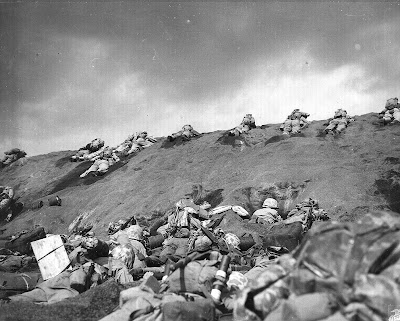 The 5th Division hits the beach on D-Day, 19 February 1945. The dead and living mingle.
The 5th Division hits the beach on D-Day, 19 February 1945. The dead and living mingle."I've lived with those memories all of my life and it was not something I ever wanted to go back to."─Jerry Yelin, World War II P-51 fighter pilot, to CNN
In a recent story on CNN, World War II veterans talked about their emotional pilgrimage to Iwo Jima for the Tour of Honor, an annual commemoration of the 35-day battle.
In February 1945, some 80,000 U.S. Marines attacked the heavily defended fortress thatt the Japanese had constructed on the tiny Pacific Island. About 22,000 Japanese soldiers died defending Iwo Jima, along with more than 6,000 Americans.
The article alludes to how the battle proved to be "longer and deadlier than planners had anticipated, depleding much of the U.S. military's resources."
In The Ghosts of Iwo Jima (Texas A&M University Press, 2006), Captain Robert S. Burrell reconsiders the costs of taking Iwo Jima and its role in the war effort. He asserts that the Air Forces' fighter operations on Iwo Jima subsequently proved both unproductive and unnecessary.

An excerpt:
"With the start of World War II, the U.S. armed services made enormous transitions. The size of the naval operations dwarfed anything witnessed in American history. At the same time, the Army and Navy were forced to work together as never before in ambitious joint operations. Since the pre-war military had distinctly divided Army and Navy responsibilities based upon geographical boundaries of land and sea, amphibious operations in the Pacific left much ambiguity over how best to integrate service efforts. The creation of the Joint Chiefs of Staff was a giant leap forward in unified command of the armed services. Still, the Army and Navy had great difficulty working together, both in Washington and abroad. Intense rivalry continued to influence problematic command arrangements and had tragic repercussions, especially in the Pacific.
Considering Iwo Jima within the overall context of the Pacific war demonstrates that Operation Detachment was influenced by U.S. service interests. Plans to seize Iwo Jima began as a result of Army Air Forces strategy. The Army Air Forces sought to provide fighter escort from an intermediate air base between the Marianas and Japan in order to improve B-29 Superfortress performance. Although there were many small islands in the Nanpo Shoto, none had both the ideal terrain and the proper location to meet the Army Air Forces' requirements. Because General Arnold desperately sought to demonstrate the value of an independent air force through the performance of the B-29, he strongly urged the capture of the most suitable island anyway. Although Iwo Jima had an appropriate landscape for large airfields, distance from mainland Japan, adverse weather conditions, and limitations of the P-51 Mustang proved detrimental to effective U.S. fighter support. Planners from 1943 onward had expressed doubts that seizing Iwo Jima would justify its cost. They also doubted the ability of fighters to operate such long distances to mainland Japan. Admiral Spruance, ther leading Navy officer to adhere to the Army Air Forces' desires, retained deep reservations about the island's value throughout the planning and preparation process. In retrospect, one could certainly question whether the price was worth the gain─an approach that strongly contrasts with the embellished justifications given in most scholarship on the subject. . . "